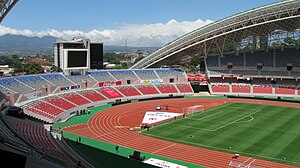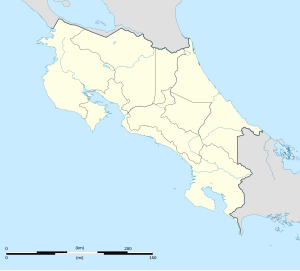1991 UNCAF Nations Cup
| Torneo de Naciones de la UNCAF Costa Rica 1991 (in Spanish) | |
|---|---|
| Tournament details | |
| Host country | Costa Rica |
| Dates | 26 May – 2 June |
| Teams | 4 (from 1 sub-confederation) |
| Venue(s) | 1 (in 1 host city) |
| Final positions | |
| Champions | |
| Runners-up | |
| Third place | |
| Fourth place | |
| Tournament statistics | |
| Matches played | 6 |
| Goals scored | 14 (2.33 per match) |
| Attendance | 77,500 (12,917 per match) |
| Top scorer(s) | |
1993 → | |
The 1991 UNCAF Nations Cup was the inaugural UNCAF Nations Cup, the Central American championship for men's national association football teams. It was organized by the Unión Centroamericana de Fútbol or UNCAF, and it took place in Costa Rica from 26 May to 2 June 1991. All matches were played in the Costa Rican capital, San José at the Estadio Nacional. The top two teams, apart from Costa Rica, go on to participate in the 1991 CONCACAF Gold Cup. Costa Rica were given a bye due to their performance at the 1990 FIFA World Cup.
Three teams qualified to enter the tournament alongside hosts Costa Rica, chosen to hold the tournament by UNCAF that same year. The teams played in a round-robin format, with the winner being the squad who obtained the best overall results. The first UNCAF Nations Cup match took place between El Salvador and Guatemala. Since the match ended in a 0-0 draw, the following one between Costa Rica and Honduras produced the first goal in UNCAF Nations Cup history. It was scored by Róger Gómez of Costa Rica. The mascot of the competition was a boy named "Minchito '91".
Hosts and pre-tournament favourites Costa Rica earned 6 points from three wins after defeating Guatemala 1–0 in front of a crowd of 16,500 people, and became the first nation to win the UNCAF Nations Cup.
Host selection
[edit]
During the Confederation of North, Central American and Caribbean Association Football (CONCACAF) Congress in Guatemala City, Guatemala on 26 January 1991, the qualification rounds for the inaugural CONCACAF Gold Cup was decided upon.[1] Since Costa Rica were given a bye into the competition due to its first place standing at the 1989 CONCACAF Championship, which also served as a qualification phase for the FIFA World Cup hosted by Italy in 1990, they weren't required to participate in the preliminary stages.[1] However, the final qualification round of the Central American zone had two bids: the United States and Costa Rica.[2] Costa Rica won the bid and was named by CONCACAF and UNCAF as the host nation of the inaugural UNCAF Nations Cup tournament on 19 February 1991.[3]
Qualification
[edit]The draw for the 1991 UNCAF Nations Cup qualifying competition for Central America took place in Guatemala City on 26 January 1991.[1] Six teams entered to compete for the three remaining places in the competition, alongside eventual host Costa Rica. The teams were divided into three groups of two. As the host nation of the event, Costa Rica qualified automatically.[3] The qualifying process began in April 1991 and concluded in May 1991.[1] At the conclusion of the qualifying group stage, the three group winners qualified for the tournament.[1]
Qualified teams
[edit]The following four teams qualified for the finals:[4]
| Country | Qualified as | Qualified on | Previous appearances in tournament |
|---|---|---|---|
| Host nation | 19 February 1991 | 0 (debut) | |
| Group 2 winner | 24 April 1991 | 0 (debut) | |
| Group 3 winner | 12 May 1991 | 0 (debut) | |
| Group 1 winner | 12 May 1991 | 0 (debut) |
Match officials
[edit]A list of 13 referees from eight football federations for the tournament were chosen to participate in the tournament.[5]
- Referees
|
|
|
Venues
[edit]Stadium
[edit]The Estadio Nacional, Costa Rica's national stadium and home of the Costa Rica national football team, was announced as the sole venue of the tournament.[3]
| San José | |
|---|---|
| Estadio Nacional | |
| Capacity: 35,060 | |
 |
Accommodations
[edit]Hotels and base camps were used by the four national squads to stay and train
before and during the UNCAF Nations Cup tournament. All teams opted to stay
in hotels in San José.[4]
| Team | Site | City |
|---|---|---|
| Hotel Tennis Club | San José | |
| Hotel Plaza | San José | |
| Hotel Ambassador | San José | |
| Hotel Ambassador | San José | |
| CONCACAF Delegation | Hotel Corobicí | San José |
| UNCAF Delegation | Hotel Corobicí | San José |
| UNCAF Referees Committee & Officials | Hotel Europa | San José |
| VIPs | Hotel Corobicí | San José |
Training grounds
[edit]Six venues were chosen as training grounds. Most teams opted to train
outside San José. Only Costa Rica trained in the national capital on privately
owned football pitches.[6]
| Team | Venue | City |
|---|---|---|
| Cancha Firestone | San José | |
| Cancha Republic Tobacco Company | San José | |
| Cancha Firestone | San José | |
| Estadio Alejandro Morera Soto | Alajuela | |
| Cancha Tabacalera Costarricense | San José | |
| Estadio Eladio Rosabal Cordero | Heredia | |
| Cancha Tabacalera Costarricense | San José | |
| Estadio José Fello Meza | Cartago | |
| Cancha Republic Tobacco Company | San José |
Mascot
[edit]
Minchito '91, the mascot for the 1991 competition, was the first UNCAF Nations Cup mascot, and one of the first mascots to be associated with a major sporting competition in Central America. Inspired in "the traditions, beliefs, legends and customs of Costa Rica", Minchito was born as an authentic peasant. The boy, who is seven-years-old, was created by the Hispanic Publicity Company. The name is a diminutive of the name 'Benjamín' in Costa Rica. Minchito is dressed with a white shirt, a red scarf and belt with black shorts, the most common set of clothes of a Costa Rican peasant.[7]
Squads
[edit]Each team's squad consisted of 18 players (two of whom must be goalkeepers). Teams also had two additional reserve players they could use as replacements in the event of serious injury, at any time. During a match, all remaining squad members not named in the starting team are available to be one of the three permitted substitutions (provided the player is not serving a suspension).[8]
Tournament overview
[edit]Format
[edit]All times are Central Time Zone (UTC-6) In the following tables:
- Pld = total games played
- W = total games won
- D = total games drawn (tied)
- L = total games lost
- GF = total goals scored (goals for)
- GA = total goals conceded (goals against)
- GD = goal difference (GF−GA)
- Pts = total points accumulated
The four teams played in round-robin format to determine the winner. This format would guarantee each team at least three games. Each team were awarded 2 points for a win and 1 point for a draw.[9]
If two or more teams were equal on points on completion of the group matches, the following tie-breaking criteria were applied:[9]
- Greatest total goal difference in the three group matches
- Greatest number of goals scored in the three group matches
- If teams remained level after those criteria, a mini-group would be formed from those teams, who would be ranked on:
- Most points earned in matches against other teams in the tie
- Greatest goal difference in matches against other teams in the tie
- Greatest number of goals scored in matches against other teams in the tie
- If teams remained level after all these criteria, UNCAF would hold a drawing of lots
Results
[edit]| Team | Pld | W | D | L | GF | GA | GD | Pts |
|---|---|---|---|---|---|---|---|---|
| 3 | 3 | 0 | 0 | 10 | 1 | +9 | 6 | |
| 3 | 1 | 1 | 1 | 2 | 3 | −1 | 3 | |
| 3 | 0 | 2 | 1 | 0 | 1 | −1 | 2 | |
| 3 | 0 | 1 | 2 | 2 | 9 | −7 | 1 |
| El Salvador | 0–0 | |
|---|---|---|
| Costa Rica | 2–0 | |
|---|---|---|
| Gómez Jara |
Report |
| Costa Rica | 7–1 | |
|---|---|---|
| Jara Flores Gómez Gómez |
Report | Arce |
| El Salvador | 1–2 | |
|---|---|---|
| Rivera |
Espinoza Machado |
| Costa Rica | 1–0 | |
|---|---|---|
| Jara |
Report |
Statistics
[edit]Goalscorers
[edit]Claudio Jara received the Golden Boot for scoring five goals. In total, 14 goals were scored by 8 different players.
- 1 goal
All-Star Team
[edit]Chilean sports magazine Triunfo evaluated player performances through statistical data finished with the following players leading each position.[10]
| Goalkeepers | Defenders | Midfielders | Forwards |
|---|---|---|---|
|
|
|
References
[edit]- ^ a b c d e "Torneo de Naciones de CONCACAF: Costa Rica busca la ratificacion de sede" [CONCACAF Nations Cup: Costa Rica looks for ratification on host bid] (Web). La Nación (in Spanish). January 25, 1991. p. 39A. Retrieved October 13, 2014.
- ^ "En Julio Copa de Naciones" [Nations Cup in July] (Web). La Nación (in Spanish). January 27, 1991. p. 42A. Retrieved October 13, 2014.
- ^ a b c d e f g h i j k l m n o "Torneo de Naciones Inicia el 26 de Mayo" [Nations Cup starts May 26] (Web). La Nación (in Spanish). February 20, 1991. p. 29A. Retrieved October 13, 2014.
- ^ a b c "Selecciones Llegan el Próximo Viernes" [National Teams Will Arrive Next Friday] (Web). La Nación (in Spanish). May 21, 1991. p. 34A. Retrieved September 17, 2014.
- ^ "UNCAF en Apuntes" [Notes on UNCAF] (Web). La Nación (in Spanish). May 23, 1991. p. 43A. Retrieved September 17, 2014.
- ^ a b "Escogidas Seis Sedes Para Entrenamientos" [Six Venues Chosen as Training Grounds] (Web). La Nación (in Spanish). May 25, 1991. p. 34A. Retrieved September 17, 2014.
- ^ "Minchito, ¡Puro Mais!" [Minchito, Pure Corn!] (Web). La Nación (in Spanish). May 27, 1991. p. 4C. Retrieved September 17, 2014.
- ^ "Prensa Escogerá al Mejor Jugador" [Press Will Pick Best Player] (Web). La Nación (in Spanish). May 24, 1991. p. 44A. Retrieved September 16, 2014.
- ^ a b "UNCAF en Apuntes" [Notes on UNCAF] (Web). La Nación (in Spanish). May 24, 1991. p. 45A. Retrieved September 17, 2014.
- ^ "Buzón de Rodrigo Calvo - 13 de octubre de 2014" [Rodrigo Calvo's Mailbox - October 13, 2014] (Web). La Nación (in Spanish). October 13, 2014. Retrieved October 13, 2014.
External links
[edit]- Official website (in Spanish)


